10 Diseases That Will Make Your Skin Crawl
10 Diseases That Will Make Your Skin Crawl
The skin. It's the largest organ of the body. It's your first line of defense against infection. Yet like any organ of the body, the skin is prone to all manner of horrific maladies, some of which will make your skin crawl... right off your body.
10. Stevens-Johnson Syndrome
It started off innocuously enough. “Damn,” you said. “I'm getting the flu.” You have a fever. You have a sore throat. You feel tired. You're coughing. Your eyes are dry and burning. Suddenly, you have a rash. You think nothing of it. Until the rash begins to spread. Your skin begins to hurt. It begins to blister. You have pain everywhere, and that's when your skin begins to die and shed like a snake's.
You have Stevens-Johnson Syndrome [LINK 15]. It's a form of Toxic Epidermal Necrolysis, which as the name implies is when your skin dies. The treatment involves IV fluids, salving your blisters, administering pain medication, and giving you something to reduce the itching. Your immune system, which has been triggered by either a bad reaction to a new medication or a viral infection, has betrayed you. Mortality is frequent, and those who do survive are often left with irreversible skin damage.
9. Sitting Disease
Like any organ of your body, the skin is in a constant state of growing, shedding, repairing itself, and renewing itself. While evolution has done a great job of preparing for any contingency that might befall you, it had never occurred to any of our ancestors to sit in one place for two years. So you shouldn't be surprised, for instance, if you find your posterior adhered to the toilet seat.
Such was the plight of one (now infamous) Kansas woman, Pam Babcock [LINK 13], whose skin had grown around the toilet seat when she was finally involuntarily rescued by EMTs. She and the toilet seat were then transported to the hospital where surgeons had to cut it from her buttocks.
In this instance the underlying culprit was a severe form of agoraphobia. But Sitting Disease [LINK 14] in less extreme forms is a serious problem for modern people. Doctors warn that those who sit most of the day are at increased risk for obesity, heart disease, depression, high blood pressure, and diabetes. And if you're not careful, your ass may just stick to your chair.
8. Krokodil Dependence
Krokodil (AKA Desomorphine) is the newest rage for opiate enthusiasts. With a high that lasts half as long but hits you twice as hard, it's heroin's response to crack. [LINK 12]
The name itself, “Krokodil,” refers to the skin damage the drug causes. In extreme cases it causes your skin to fall right off, making you look more like an extra from The Walking Dead than anything resembling a crocodile.
Let's take a look at the ingredient list: codeine, iodine, gasoline, paint thinner, hydrochloric acid, lighter fluid and red phosphorus. Yum. Everything a growing boy needs. What are those vaguely reptilian effects you are seeing on your skin from ingesting Krokodil? Why, that's gangrene. Yes, gangrene. Soft tissue damage begins around the injection site. Eventually it becomes necrotic and dies, eating its way into the muscle, and then into the bone itself. Luckily, amputation is still an effective treatment for gangrene.
7. Harlequin Ichthyosis
Harlequin Ichthyosis [LINK 10] is a severe form of a genetic ailment that gives the skin the appearance of being scaly and fishlike. With Harlequin type ichthyosis the skin cracks where it would normally fold leaving a pattern of red lines that look like a clown's costume. The lower eyelids of those afflicted are inverted turning outward, appearing like demonic red eyes. Sometimes the ears and nose are missing. The excessively hard skin makes movement difficult and, worse still, impairs breathing. Respiratory failure is a common cause of death among those suffering from this awful disease.
In modern times, the prognosis has improved. Treatment involves constant upkeep to allow the scaly skin to retain its moisture. The moisture is necessary in warm-blooded creatures to regulate body temperature. Since the skin of those afflicted is impermeable, it prevents heat loss, making the infant extremely sensitive to any change in temperature. Infants are thus kept in humidified incubators, and treatments targeting the skin to keep it moisturized have been miraculously effective. The disease itself is not fatal, and by treating the complications that arise from it doctors have expanded the lifetime of sufferers indefinitely [LINK 11].
6. Darier's Disease
Darier's [LINK 9] is a genetic abnormality that involves periods of breaking out into pustules. Breakouts are triggered by humidity, heat, direct sunlight, stress, or even if your skinny jeans are too skinny. The rash forms within the hair follicles, and its characteristic warts also emit a malodorous stench, meaning you stink as well. The first occurrence of the warts appear in adolescence, making those awkward teenage years all the more awkward and teen aged. Papules can form in your mouth as well, so you'd better stock up on breath mints.
5. Necrotizing Fasciitis
Also known as flesh-eating bacteria, necrotizing fasciitis [LINK 7] is one of the few diseases on this list that is not genetic in origin. Its likely cause is a particularly malevolent form of staph infection bred out of the bowels of hospitals. These so called super bugs, such as MRSA [LINK 8], are the result of generations of over-sterilization, which evolved antibiotic-resistant forms of otherwise common diseases.
It begins with an innocuous abrasion. The pain is extraordinary. Now you have a fever. Your heart is pounding out of your chest. Your wound becomes swollen. It darkens and blisters. You're nauseous. You have diarrhea. The wound is making a crackling sound as air begins to escape from within your skin, oozing a grotesque liquid that looks like dirty dishwater. What initially looked like a minor laceration is beginning to turn black.
You're rushed to the hospital. They'll have to cut the infected tissue off your body to prevent it from spreading. This could even involve amputation.
4. Excoriation Disorder
Everyone has annoying blemishes on their skin. From pimples to bug bites, moles and birthmarks, scabs and scrapes, we all have them. What most of us do not have is a nagging need to rip and scratch at our flesh, and we certainly do not have a feeling of relief and pleasure after having done so. This is why, unlike so many other forms of Obsessive Compulsive Disorder, Excoriation Disorder [LINK 6] is notoriously difficult to cure. The patient has become addicted to rending their own flesh.
The primary trigger for self-harming behaviors is anxiety, which is a feeling of persistent agitation. But what if you can temporarily stay the sense of alarm merely by picking at your own skin?
The results are often tragic. It is not uncommon for those afflicted with Excoriation Disorder to implement tools such as tweezers and needles. Sometimes they gnaw at their own skin. The damage can be so bad that skin grafts are necessary. The area can become putrid from infection.
3. Lewandowsky-Lutz dysplasia
Also known as the Tree Man Disease, Lewandowsky-Lutz dysplasia [LINK 5] is a rare form of genetic disorder characterized by an extreme vulnerability to HPV. Yes, HPV. The disease all the public service announcements warned you that 100% of your college lovers would have. The resulting sensitivity results in the uncontrolled formation of warts, particularly on the hands and feet. This of course makes walking and picking things up incredibly difficult as the warts themselves can grow warts, and left untreated they can become cancerous and will continue to grow indefinitely giving the afflicted the appearance of growing into a tree.
No cure has been found, and treatment involves mitigating the symptoms by removing the warts accompanied by antivirals that slow the progression of the HPV.
2. Xeroderma pigmentosum
Xeroderma pigmentosum [LINK 3] is a genetic disorder characterized by an extreme sensitivity to UV light. It's one of the conditions that, like porphyria, may have contributed to the vampire legend. It has the dubious glory of contributing one of the most iconic ways of vanquishing a vampire: by exposing it to direct sunlight.
Individuals [LINK 4] born with xeroderma pigmentosum cannot repair the damage done to the skin caused by even minimal exposure to sunlight. The result is often fatal. Less than 40% of those born with the disorder live beyond the age of 20. On the upside, the treatment is only marginally invasive: stay out of direct sunlight. The consequences for not following up on this treatment are, in all instances, skin cancer. The effect is cumulative. Every time a ray of sunlight hits your skin, you're that much closer to death. Sun screens specifically designed for xeroderma pigmentosum have been developed and are effective. Gene therapies that repair skin damage are still in the experimental stage.
1. Neurofibromatosis Type 1
Neurofibromatosis Type 1 is a genetic disorder that causes tumors [LINK 1] to grow in the fatty sheaths that protect the nerves. In some instances, multiple bulbous protrusions form covering the whole body, giving the skin the appearance of being covered in bubbles. In other instances, the uncontrolled growth forms in a plexus [LINK 2] – a network of interconnected cells.
Patients with this disfigurement often have the appearance of melting, as the skin on their body (very often their face) droops and hangs like an ill-fitting mask. The disfigurement can be so severe that it erodes all the features of the face leaving nothing behind but an amporphous blob. For this reason, Neurofibromatosis Type 1 made this list as the most horrific skin disease known to humankind.
Citations
1. Neurofibromatosis Type 1
LINK 1: https://ghr.nlm.nih.gov/condition/neurofibromatosis-type-1
LINK 2: http://radiopaedia.org/articles/plexiform-neurofibroma
2. xeroderma pigmentosum
LINK 3: https://ghr.nlm.nih.gov/condition/xeroderma-pigmentosum
LINK 4: http://www.medicaldaily.com/rare-skin-disease-makes-people-brazilian-village-melt-away-what-xeroderma-pigmentosum-280828
3. Lewandowsky-Lutz dysplasia
LINK 5: http://www.ncbi.nlm.nih.gov/pmc/articles/PMC3108519/
4. Excoriation Disorder
LINK 6: http://www.webmd.com/mental-health/skin-picking-disorder
5. Necrotizing Fasciitis
LINK 7: http://www.cdc.gov/features/necrotizingfasciitis/
LINK 8: http://www.mayoclinic.org/diseases-conditions/mrsa/basics/definition/con-20024479
6. Darier's Disease
LINK 9: https://ghr.nlm.nih.gov/condition/darier-disease
7. Harlequin Ichthyosis
LINK 10: https://ghr.nlm.nih.gov/condition/harlequin-ichthyosis
LINK 11: http://www.express.co.uk/life-style/life/546525/Skin-condition-fish-scales-Harlequin-Ichthyosis
8. Krokodil Dependence
LINK 12: http://www.narconon.org/drug-abuse/desomorphine-effects.html
9. Sitting Disease
LINK 13: http://www.nbcnews.com/id/23618592/ns/health-health_care/t/woman-had-phobia-leaving-bathroom/
LINK 14: http://www.mayoclinic.org/healthy-lifestyle/adult-health/expert-answers/sitting/faq-20058005
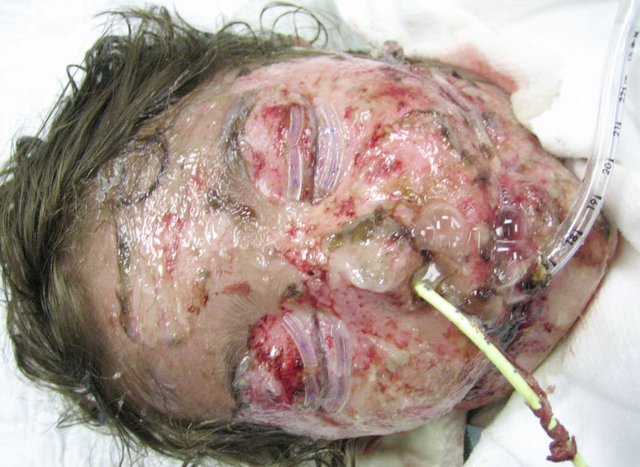


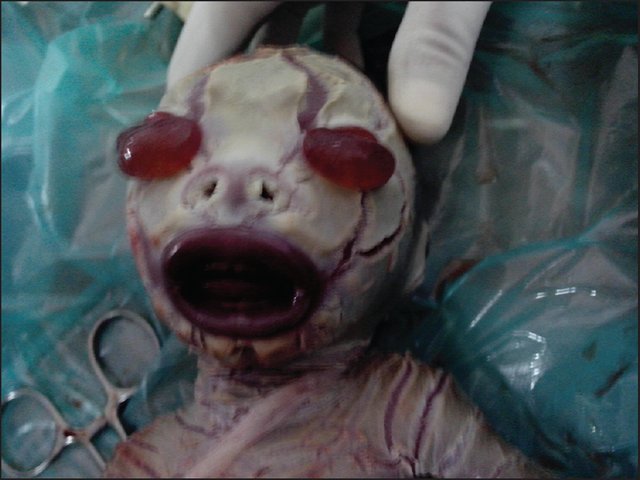
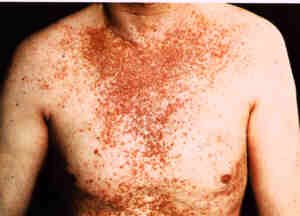
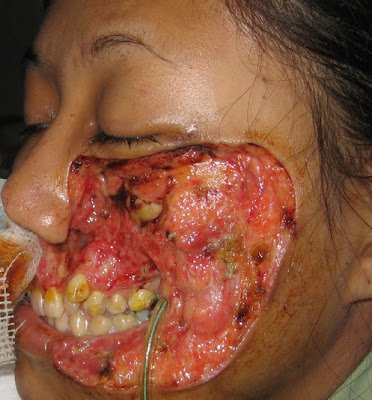
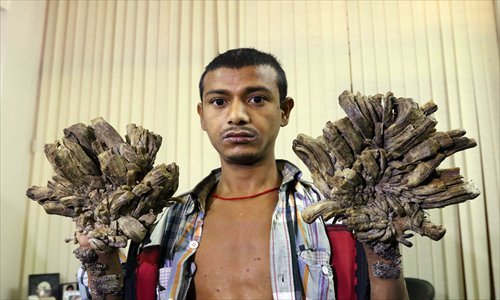
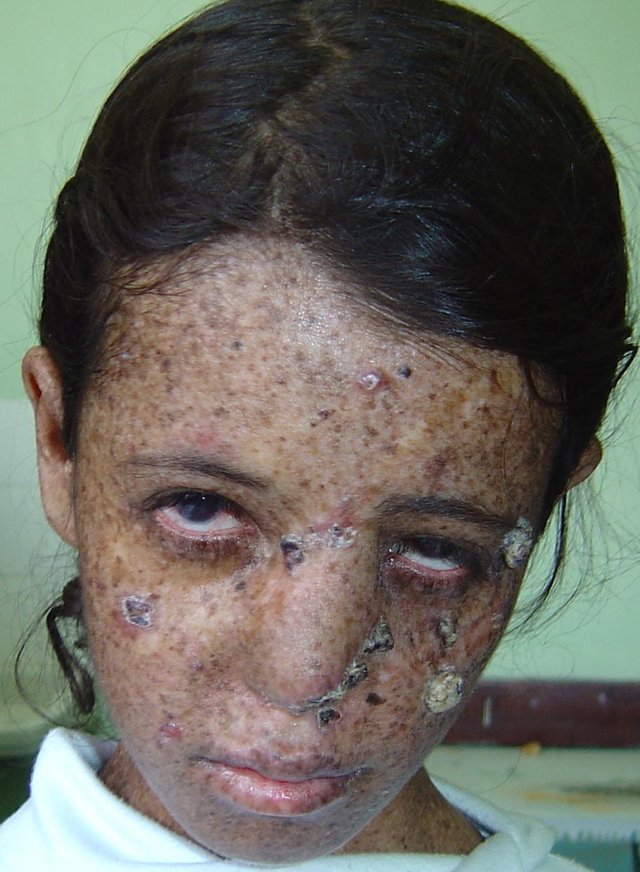

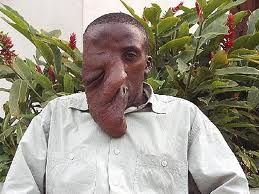
Ewwwwww! Very well written, but those photos will haunt my dreams!
Omg..i thought I had problems